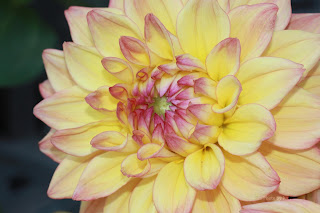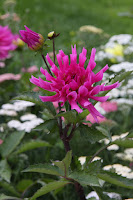Dahlia
My story with dahlias:
I had a friend who had a large garden filled with dahlias of all shapes, sizes, and colors (not black). It was magnificent! I had never seen such a beautiful garden. I had also never seen the dahlia. As dahlias cannot live in cold climate, my friend would dig them up and save them until spring when he planted them yet again. Each year they came up more beautiful than the year before. We used to visit Jack and he'd show us his garden each year for about four years. I wish he were still here today. He was an amazing man.
Dahlias originated in Mexico. It was the Aztecs who grew them. People would visit Mexico, love the dahlia and take them home. As this happened, dahlias spread around the world. They are named after Anders Dahl, a botanish from Sweden. I had a friend who had a large garden filled with dahlias of all shapes, sizes, and colors (not black). It was magnificent! I had never seen such a beautiful garden. I had also never seen the dahlia. As dahlias cannot live in cold climate, my friend would dig them up and save them until spring when he planted them yet again. Each year they came up more beautiful than the year before. We used to visit Jack and he'd show us his garden each year for about four years. I wish he were still here today. He was an amazing man.
Have you ever seen a garden of dahlias? It's a sight to behold. It is said that they are the most glorious flower. Their stems are between 12 inches and 6-8 feet tall. The difference is in the variety of dahlia.They come in 42 varieties and, if you have a variety in your garden, you will have them blooming at different times. They are related to the daisy, sunflower, chrysanthemum, and aster.
Their leaves come in a variety of shades of green and shapes, depending upon the variety of dahlia.
As stated above, dahlias come in different sizes. They come as small as a saucer and as large as a dinner plate. To think that a stem can hold such magnificence!
Dahlias are edible. Both the petals and the tubers (the "bulbs") are edible. You can use them to decorate cakes, salads and more. No, I don't believe I've had a dahlia. Have you?
Believe it or not, dahlias have no fragrance. This especially helps if you want to give flowers to someone who is sensitive to scents.
Have you seen a dahlia? If so, what do you think of them? If not, keep your eyes open. They may show up in bouquets or a garden near you.
Each of the above prints are available for purchase.
Thank you for visiting!
Judy
Reference:
https://www.almanac.com/plant/dahlias
http://www.flowermeaning.com/dahlia-flower-meaning/
Wells, D. (1997). 100 Flowers And How They Got
Their Names.








